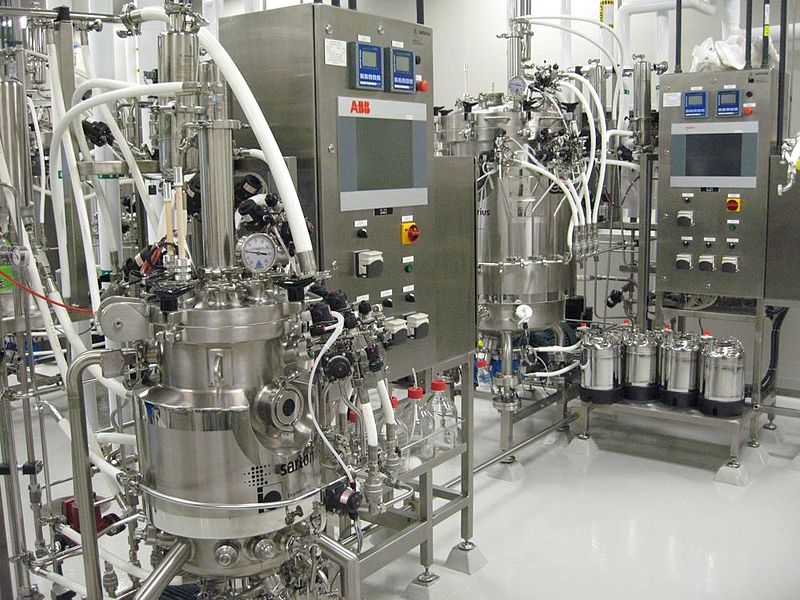What is the difference between bioreactor and fermenter?
Bioreactor and fermenter are a closed system that is used for a particular type of biochemical reaction. These systems happen in plants, animals, and industrial applications.
The main difference between bioreactor and fermenter is that the former refers to a close system that facilitates various types of biochemical reactions while the latter refers to a vessel that facilitates fermentation.
You May Also Enjoy: Difference between Anaerobic and Aerobic Respiration

Comparison Table (Bioreactor vs Fermenter)
| Basic Terms | Bioreactor | Fermenter |
| Meaning | It is an apparatus where the biological reaction is carried out on an industrial scale | It is a container where the fermentation process takes place |
| Type of Reaction | Allow any type of biological reaction to take place | Only facilitate the fermentation process |
| Products Obtained | Metabolites like amino acids, peptides, and drugs | Alcohol and acids only |
| Organisms Involved | Plant cells, animal cells, and unicellular microbes | Fermentative microbes |
| Aerobic or Anaerobic | Function under both anaerobic and aerobic conditions | Function only under anaerobic condition |
| Types of Designs | Bioreactors have packed beds, fluidized bed, and airlift bioreactors | Batch and continuous or fed-batch |
| Viral Infection | Infected by viruses | Not infected by viruses |
| Types of Metabolites | Vaccines, amino acids, antibodies, medicines, and pharmaceutical liquids | Lactic acid and ethanol |
| Purpose | Produce cell mass or particular metabolites | Produce metabolite |
| Double Timing | Tend to belong | Take about 20 minutes |
| Agitation RPM | Need to be maintained due to cells without a cell wall | No need for maintaining since bacteria and fungi have cell walls |
| Volume | Numerous liters | About two liters |
| Height of the Vessel | Short vessels due to mammalian cell culture to improve mixing | Taller vessels due to bacterial culture to improve oxygen mass transfer |
| Origin of Microorganisms | Microorganisms have introduced to the apparatus | Microorganisms in the air are used in the fermenter |
| Correspondence | A vessel that facilitates the biological reaction | It is a type of bioreactor |
| Type of Substrate | Various types of bioreactor | Glucose compounds |
| Microorganisms | Either microorganism or biochemically active | Uses microorganism only |
What Is a Bioreactor?
It is an advanced version of fermentation technology that involves the production of substances on an industrial scale. The process entails the use of biochemically active substances like enzymes.
The process is usually carried by plant and animal cells. It also helps to facilitate the cultivation of secondary metabolites such as vaccines, antibodies, and pharmaceutical products.
Bioreactors are classified as Airlift bioreactors, fluidized bioreactors, packed-bed, photobioreactors, bubble column bioreactors, and continuous bioreactors.
The primary aim of the bioreactor is to subject all parts of the system under the same conditions. It is the reason behind further classification into the biofilm and the process of cell cultures.
The most essential role of a bioreactor is to promote various types of biochemical reactions and double-timing the entire process.
You Also Like: Difference between Batch and Continous Fermentation
What Is a Fermenter?
It is a biological process that takes place in absence of oxygen. It is also known as fermentation or anaerobic respiration.
Production of lactic acid and ethanol in fermentation is enhanced by bacteria and fungi. The fermenter provides optimal temperature and nutrients for these microorganisms.
The fermenter is classified as batch and fed-batch or continuous culture. These types of fermenters can be performed as submerge fermentation and surface fermentation.
Submerged fermentation is where the process of microorganism occurs in a liquid medium while surface fermentation is a solid medium.
Timing for fermenter is about 20 minutes and it supports the cultivation of bacteria and fungi. But the apparatus only support fermentation only.
Main Differences between Bioreactor and Fermenter
- The bioreactor is an apparatus that allows the biological process to be carried out on a large scale while the fermenter is a container that facilitates fermentation only
- Bioreactor facilitate the biochemical process while fermenter is a type of bioreactor
- Bioreactor uses mammalian or insect cells while fermenter uses fungal and bacterial cells
- Bioreactor uses either anaerobic or aerobic conditions whereas fermenter uses anaerobic conditions.
- Bioreactor double-timing is long whereas fermenter is about 20 minutes
- Bioreactor produce secondary metabolites while fermenter produce a primary metabolite
- The bioreactor is used in the production of medicine and vaccines while the fermenter is used in the production of ethanol or lactic acid
- The bioreactor can be infected by viruses whereas the fermenter cannot be infected by viruses
You May Also Like: Difference between Catabolism and Anabolism
Similarities between Bioreactor and Fermenter
- Both are a closed system
- Both operate on a large scale
- Both are cylindrical vessels made from stainless steel
- Both provide agitation, sterility, aeration, and regulation of factors
- Both are the type of apparatus meant for specific chemical reaction
Comparison Video
In Conclusion
We hope the difference between fermenter and bioreactor discussed in the article is useful. The bioreactor is a device that facilitate various types of biochemical processes whereas a fermenter is an apparatus that enhance fermentation.
Scientists use bioreactors for the production of pharmaceutical products and vaccines while fermenters for the production of lactic acid and ethanol. The type of biochemical reaction helps to distinguish between bioreactor and fermenter.
More Sources and References
- https://en.wikipedia.org/wiki/Bioreactor
- https://www.coursera.org/lecture/industrial-biotech/microbial-fermentation-processes-and-bioreactor-design-35cbb